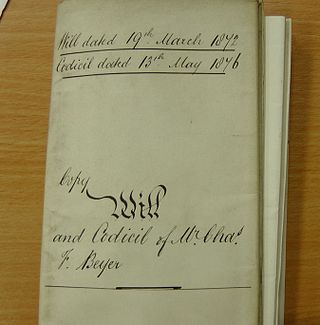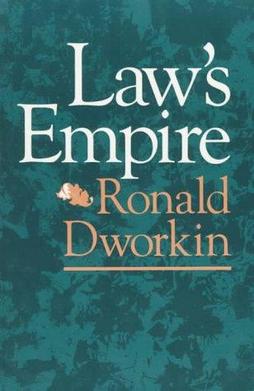
Jurisprudence is the philosophy and theory of law. It is concerned primarily with both what law is and what it ought to be. That includes questions of how persons and social relations are understood in legal terms, and of the values in and of law. Work that is counted as jurisprudence is mostly philosophical, but it includes work that also belongs to other disciplines, such as sociology, history, politics and economics.

Philosophy of law is a branch of philosophy that examines the nature of law and law's relationship to other systems of norms, especially ethics and political philosophy. It asks questions like "What is law?", "What are the criteria for legal validity?", and "What is the relationship between law and morality?" Philosophy of law and jurisprudence are often used interchangeably, though jurisprudence sometimes encompasses forms of reasoning that fit into economics or sociology.
A statute of limitations, known in civil law systems as a prescriptive period, is a law passed by a legislative body to set the maximum time after an event within which legal proceedings may be initiated. In most jurisdictions, such periods exist for both criminal law and civil law such as contract law and property law, though often under different names and with varying details.
In a legal dispute, one party has the burden of proof to show that they are correct, while the other party has no such burden and is presumed to be correct. The burden of proof requires a party to produce evidence to establish the truth of facts needed to satisfy all the required legal elements of the dispute.

A will and testament is a legal document that expresses a person's (testator) wishes as to how their property (estate) is to be distributed after their death and as to which person (executor) is to manage the property until its final distribution. For the distribution (devolution) of property not determined by a will, see inheritance and intestacy.
A writ of prohibition is a writ directing a subordinate to stop doing something the law prohibits. This writ is often issued by a superior court to the lower court directing it not to proceed with a case which does not fall under its jurisdiction.
Legal positivism is a school of thought of philosophy of law and jurisprudence which holds that law is constructed from social facts, without regards to the merits of such law. It was developed largely by legal philosophers during the 18th and 19th centuries, such as Jeremy Bentham and John Austin. While Bentham and Austin developed legal positivist theory, empiricism provided the theoretical basis for such developments to occur. Some of the most prominent legal positivist writers of the 20th century have been Hans Kelsen, H. L. A. Hart, and Joseph Raz.
Legal realism is a naturalistic approach to law; it is the view that jurisprudence should emulate the methods of natural science, that is, it should rely on empirical evidence. Hypotheses must be tested against observations of the world.

Ronald Myles Dworkin was an American legal philosopher, jurist, and scholar of United States constitutional law. At the time of his death, he was Frank Henry Sommer Professor of Law and Philosophy at New York University and Professor of Jurisprudence at University College London. Dworkin had taught previously at Yale Law School and the University of Oxford, where he was the Professor of Jurisprudence, successor to philosopher H. L. A. Hart.

Herbert Lionel Adolphus Hart was an English legal philosopher. He was the Professor of Jurisprudence at Oxford University and the Principal of Brasenose College, Oxford. His most famous work is The Concept of Law, which has been hailed as "the most important work of legal philosophy written in the twentieth century". He is considered one of the world's foremost legal philosophers in the twentieth century.
Lon Luvois Fuller was an American legal philosopher best known as a proponent of a secular and procedural form of natural law theory. Fuller was a professor of law at Harvard Law School for many years, and is noted in American law for his contributions to both jurisprudence and the law of contracts. His debate in 1958 with the prominent British legal philosopher H. L. A. Hart in the Harvard Law Review was important in framing the modern conflict between legal positivism and natural law theory. In his widely discussed 1964 book The Morality of Law, Fuller argues that all systems of law contain an "internal morality" that imposes on individuals a presumptive obligation of obedience. Robert S. Summers said in 1984: "Fuller was one of the four most important American legal theorists of the last hundred years".

Wills have a lengthy history.

Lapse and anti-lapse are complementary concepts under the US law of wills, which address the disposition of property that is willed to someone who dies before the testator.

The slayer rule, in the U.S. law of inheritance, stops a person inheriting property from a person they murdered.
The Hart–Fuller debate is an exchange between the American law professor Lon L. Fuller and his English counterpart H. L. A. Hart, published in the Harvard Law Review in 1958 on morality and law, which demonstrated the divide between the positivist and natural law philosophy. Hart took the positivist view in arguing that morality and law were separate. Fuller's reply argued for morality as the source of law's binding power.
The Hart–Dworkin debate is a debate in legal philosophy between H. L. A. Hart and Ronald Dworkin. At the heart of the debate lies a Dworkinian critique of Hartian legal positivism, specifically, the theory presented in Hart's book The Concept of Law. While Hart insists that judges are within bounds to legislate on the basis of rules of law, Dworkin strives to show that in these cases, judges work from a set of "principles" which they use to formulate judgments, and that these principles either form the basis, or can be extrapolated from the present rules.

Dillwyn v Llewelyn [1862] is an 'English' land, probate and contract law case which established an example of proprietary estoppel at the testator's wish overturning his last Will and Testament; the case concerned land in Wales demonstrating the united jurisdiction of England and Wales.
Henry Melvin Hart Jr. (1904–1969) was an American legal scholar. He was an influential member of the Harvard Law School faculty from 1932 until his death in 1969.

Kievan Rus' law or law of Kievan Rus', also known as old Russian law or early Russian law, was a legal system in Kievan Rus', in later Rus' principalities, and in the Grand Duchy of Lithuania from the 13th century. Its main sources were early Slavic customary law and Zakon Russkiy, which was partly written in Rus'–Byzantine Treaties. A number of articles have similarities with the Germanic (barbarian) laws, for example, the "Salic law" – a collection of legislative acts of Francia, the oldest text of which dates back to the beginning of the 6th century. The main written sources were Russkaya Pravda and Statutes of Lithuania.

Law's Empire is a 1986 text in legal philosophy by Ronald Dworkin, in which the author continues his criticism of the philosophy of legal positivism as promoted by H.L.A. Hart during the middle to late 20th century. The book introduces Dworkin's Judge Hercules as an idealized version of a jurist with extraordinary legal skills who is able to challenge various predominating schools of legal interpretation and legal hermeneutics prominent throughout the 20th century. Judge Hercules is eventually challenged by Judge Hermes, another idealized version of a jurist who is affected by an affinity to respecting historical legal meaning arguments which do not affect Judge Hercules in the same manner. Judge Hermes' theory of legal interpretation is found by Dworkin in the end to be inferior to the approach of Judge Hercules.